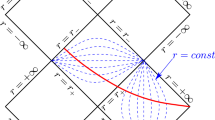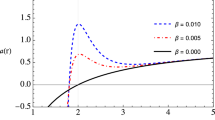Abstract.
The innermost stable circular orbit (ISCO) of a black-hole spacetime marks the boundary between stable circular geodesics of test particles and unstable geodesics that plunge into the central compact object. In the present compact paper we use the famous Thorne hoop conjecture in order to address the following physically intriguing question: Does the gravitating two-body system possess an ISCO for arbitrarily large values of the dimensionless particle-to-black-hole mass ratio \(\bar{\mu}\equiv \mu/M\)? Interestingly, analyzing the role of the hoop conjecture in this gravitating two-body system, we provide compelling evidence that the answer to this seemingly simple question may be negative in the regime \( \delta\equiv (M-a)/M\ll 1\) of near-extremal Kerr black holes. In particular, it is pointed out that, according to the Thorne hoop conjecture, a co-rotating particle that moves along the ISCO of a rapidly spinning Kerr black hole may be engulfed by a larger horizon (with \( r_{\rm horizon} > r_{\rm ISCO}\)) if its dimensionless mass parameter lies in the regime \( \bar{\mu}\gtrsim \delta^{2/3}\). To the best of our knowledge, this important conclusion, which is a direct consequence of the Thorne hoop conjecture, has gone unnoticed in the physics literature for almost five decades.
Similar content being viewed by others
References
J.M. Bardeen, W.H. Press, S.A. Teukolsky, Astrophys. J. 178, 347 (1972)
S. Chandrasekhar, The Mathematical Theory of Black Holes (Oxford University Press, New York, 1983)
S.L. Shapiro, S.A. Teukolsky, Black Holes, White Dwarfs, and Neutron Stars: The Physics of Compact Objects (Wiley, New York, 1983)
S. Hod, Phys. Rev. D 84, 104024 (2011) arXiv:1201.0068
S. Hod, Phys. Rev. D 84, 124030 (2011) arXiv:1112.3286
S. Hod, Phys. Lett. B 718, 1552 (2013) arXiv:1210.2486
K.S. Thorne, in Magic without Magic: John Archibald Wheeler, edited by J. Klauder (Freeman, San Francisco, 1972)
S. Hod, Eur. Phys. J. C 78, 725 (2018)
Author information
Authors and Affiliations
Corresponding author
Additional information
Publisher’s Note
The EPJ Publishers remain neutral with regard to jurisdictional claims in published maps and institutional affiliations.
Rights and permissions
About this article
Cite this article
Hod, S. The gravitational two-body system: The role of the Thorne hoop conjecture. Eur. Phys. J. Plus 134, 106 (2019). https://doi.org/10.1140/epjp/i2019-12620-4
Received:
Accepted:
Published:
DOI: https://doi.org/10.1140/epjp/i2019-12620-4




